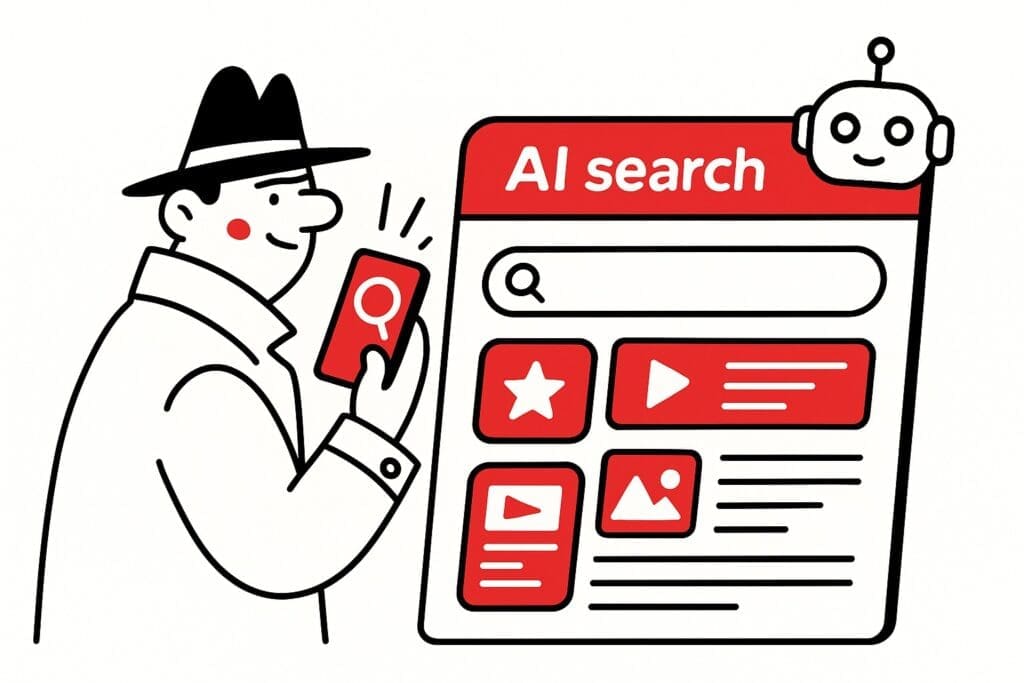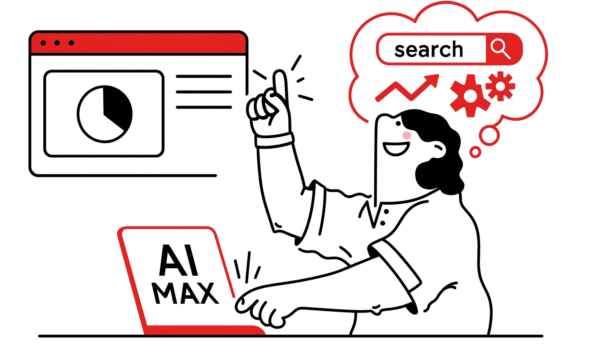Use the right content strategy and become findable in AI search engines

An effective content strategy is the foundation for achieving your goals and building a lasting relationship with your target audience. Setting a specific goal is essential to the success of your content strategy. It’s not just about creating content, but mainly about smartly deploying the right online channels, focusing on your target audience and goals, and continuously measuring the results. A strategic approach ensures that your message reaches the right people at the right time, via the right channel. Such a successful content strategy not only helps you to be visible, but also to stay top of mind with your potential customers. In this blog, you will discover how to develop your own content strategy that not only delivers relevant content, but actually contributes to achieving your goals, because good content contributes to the desired outcome, based on input from previous experience or analysis.
Better content leads to more engagement and stronger results. Good content is essential for building trust and solving problems for your target audience.

Reach goals and target audience with effective content strategy
A good content strategy begins with formulating a clear goal and sharply identifying your target audience. It is essential to know who you want to reach and what their specific needs, questions and interests are. By finding out your target audience’s needs, you can develop content that matches them. This insight forms the basis for developing content that is not only informative, but also focuses on solving your target audience’s problems and builds trust.
In doing so, it is important to understand the potential customer’s needs, especially in the early stages of the customer journey, so that you can effectively reach and guide them.
In addition, this determines which channels you will use to effectively distribute your message. It is important to understand that content creation alone is not enough; proper distribution through chosen channels is crucial. By responding to your target audience’s problems and actively solving them with your content, you increase the relevance and impact of your message.
Analysis of the target audience and competitors reveals where opportunities lie for your content strategy, allowing you to target new opportunities.
Through regular measurement and analysis, you can make adjustments to increase the effectiveness of your content strategy to achieve the desired results, stimulating your target audience to action. By carrying out concrete actions, you can make targeted adjustments and actually achieve results.
AI changes the game, but not the basics of a strong content strategy
With the rise of AI search engines such as Google SGE, Perplexity and ChatGPT’s browsing feature, the way people search and find information is changing dramatically. These systems offer instant answers and summaries, reducing traditional click behavior. This places new demands on your content strategy: how do you ensure your content remains relevant and visible in a world where AI is increasingly the first point of contact? A thorough analysis of how AI systems select and present content is essential here, as it directly affects the effectiveness of your strategy. In doing so, it is important to also analyze your competitor’s strategy to gain insight into how they deal with AI search engines and what approach they take to strengthen their online presence.
The key lies in optimizing your content for both humans and AI. This includes building your content around entities such as people, brands and concepts, rather than just focusing on keywords. In an AI-driven environment, standing out from the competition is essential to a successful content strategy; by positioning yourself relative to other players, you can gain strategic advantage. In addition, it is important to publish your content under a clear author name and expertise so that AI can recognize your content as a trusted source. In doing so, don’t forget to evaluate your current content: an analysis of your existing blog posts, ebooks and social media will help determine whether they are suitable for optimization in both traditional and AI search engines and where improvements can be made.
From SEO to Generative Engine Optimization (GEO)
While traditional SEO is still important, the rise of AI requires a new approach: Generative Engine Optimization (GEO). This means optimizing your content not only for search engines, but also for AI systems that combine and summarize information from various sources. Before creating or publishing content, it is important to plan what content will contribute to your goals and how it aligns with your overarching content strategy. In doing so, it is important to have specific guidelines and procedures for each channel to ensure that the content best fits the characteristics and audience of each channel.
To apply GEO successfully, you need to work on content depth and completeness. AI appreciates content that is comprehensive and well-researched, with clear structure and relevant context. In doing so, it is essential to deploy the right type of content for different purposes, such as informative hygiene content or inspirational hero content. Think about determining which channels to deploy within your strategy, deploying them effectively and coordinating between different channels to get the best results. In addition, it is important to focus your analysis and optimization on the channels that produce the most results. Also consider using structured data, schema.org markup and creating content clusters around central themes in which your organization excels.
A detailed content calendar helps you take a structured approach to planning and organizing GEO activities so that you always publish the right kind of content at the right time. Don’t forget the importance of well-designed landing pages, which serve as digital shop windows and strategy tools to guide visitors and increase conversions.
Writing for humans, with AI in mind
It remains essential to write content that appeals to people and inspires trust. After all, AI systems base their responses on human content, with the quality and trustworthiness of that content weighing heavily. It’s all about E-E-A-T: Experience, Expertise, Authority and Trustworthiness. It is also important to formulate clear messages in your content so that your communication comes across effectively and purposefully to both humans and AI. Sharing your content across multiple channels is essential to increase your reach and engagement.
Therefore, ensure a consistent tone of voice and a recognizable brand story. Use storytelling to reinforce your message and make your authorship visible. Think about strategically tailoring your communication to both humans and AI so that your message comes across optimally. Sometimes it is more effective to distribute your content through a different channel depending on where your target audience is. This not only strengthens the relationship with your target audience, but also increases the chance that AI will recognize and use your content as valuable. Communicating effectively with your target audience through different channels is essential here to make an impact and achieve your goals. Encourage your readers to take action after consuming your content, for example, by sharing your article or leaving a comment. Do this by adding clear call-to-actions to your content.

Content types: what formats work for AI search engines?
An effective content strategy requires the smart use of different types of content to reach and persuade your potential customers. At a time when AI search engines are increasingly determining online visibility, it is essential to choose formats that not only appeal to people but are also picked up well by AI systems. Consider blogs, infographics, videos, podcasts and interactive content. By varying types of content, you increase the chances that your message will stay top of mind with your target audience across various online channels.
The information architecture of your website plays a crucial role here. A logical structure and clear navigation ensure that both search engines and users quickly find their way to relevant content. This contributes directly to a successful content strategy because it optimizes findability and usability. By taking a strategic approach to content creation, you can target the needs of your target audience and deliver the desired results.
It’s important to analyze which channels and formats work best for your business. Perhaps blogs perform extremely well on your own website, while infographics get shared a lot on social media. By measuring and analyzing which content generates the most engagement and conversion, you can continuously optimize your strategy. This will ensure that your content marketing not only remains relevant, but actually contributes to achieving your goals.
A good content strategy is always evolving. By combining different channels and experimenting with new formats, you stay one step ahead of your competitors. Focus on relevant content that responds to the needs of your target audience, and make sure your message is spread through the right channels. This is how you build a strong online presence and increase your market share, now and in the future.
Position your brand as an authority
In an AI-driven search environment, strong brand positioning is more important than ever. Without a clear brand proposition that you consistently communicate, you run the risk of not being included in the summaries that AI presents to users. Think carefully about what you want to convey as a brand, so that your core message comes across clearly and recognizably to your target audience.
Therefore, make sure your brand strategy translates into consistent content that showcases your expertise. Think of blogs, videos, podcasts and other forms of content that underline your authority and with which you can effectively promote your product. You can also use different content in different phases of the customer journey in order to optimally serve your target audience. This not only increases your visibility, but also helps you build a lasting relationship with your target group.
Moreover, tailor your content to the products you offer so that it best meets the needs and expectations of your target audience.
Structure, information architecture and relevance: indispensable pillars for AI friendliness
AI systems benefit from well-structured content. Therefore, work with clear headings (H1, H2, etc.), bullet points and summaries. Add FAQ sections to answer users’ questions directly. This not only increases readability for humans, but also makes it easier for AI to interpret and use your content. Choosing the right topic for your content is essential here; by selecting relevant topics that match your target audience’s interests and needs, you increase your chances of success.
Build content clusters around core topics and make sure your metadata and semantic context are optimized. When creating content, always think from the user’s perspective: what question do they want answered, and what format best fits that? In addition, make sure you create content for each stage of the customer journey so that you maximize engagement and conversion. It is also important to actively manage your content and channels so that you can respond flexibly to changes and keep control of your strategy.
Infographics are an excellent example of a structured and relevant content form that you can use to present complex information attractively and clearly within your content strategy.
Channels and distribution: where do you publish your content for maximum AI findability?
An effective content strategy is not only about creating valuable content, but also about smartly deploying the right online channels. By taking a strategic approach to choosing your distribution channels, you increase the chances that your content will actually deliver the desired results. It is important to determine in advance which channels best fit the needs of your target audience and the type of content you are going to create. Consider your own website, social media, newsletters, podcasts or external platforms.
A good information architecture ensures that your content is logically structured and easy to find, both for AI search engines and potential customers. By distributing your content through the channels where your target audience is active, you increase the visibility and relevance of your message. Regularly analyze which channels are performing best and don’t be afraid to experiment with new channels or formats. This will ensure that your content strategy remains successful and that you are always responding to the changing needs of your target audience.
Implementation and measurement: how do you monitor and optimize your AI-friendly content strategy?
A successful content strategy doesn’t stop at publishing content; the real work starts after that. By combining a strategic approach with effective measurement tools, you can continuously monitor whether your content is producing the desired results. Analyze which content performs best on the chosen channels and measure whether you are achieving the set objectives. Use tools like Google Analytics, Search Console or AI-driven dashboards to gain insight into reach, engagement and conversions.
Continue to optimize your content strategy by regularly evaluating and adjusting as needed. Determine where you will make the move to improve your strategy, such as by focusing on success factors or adjusting topics within your content planning. Experiment with new topics, formats or distribution channels and learn from the results. By continuing to measure and analyze, you develop a content strategy that not only works now, but is also future-proofed in the rapidly changing AI landscape. This will ensure that your content always remains relevant and contributes to achieving your goals.
Content marketing
Content marketing is a strategic approach in which you create and distribute valuable and relevant content to attract and engage a clearly defined audience. The goal is to reach and persuade your target audience with the right content at the right time so that you ultimately achieve your organizational goals. Here it is important to focus not only on content creation, but also on effectively using the right channels to spread your message. Through a well thought out content marketing strategy, you ensure that your content does not get lost, but actually has impact.
We can help you develop and execute an effective content marketing strategy that matches your goals and target audience. From determining the right content forms and channels to setting up a content calendar and measuring results, together we ensure that your content marketing becomes successful and contributes to increasing your reach, strengthening your brand and boosting conversions.
Do you also need your own content strategy?
The rise of AI search engines is changing the way people find information online, but the core principles of an effective content strategy remain. By focusing on a strategic approach, creating valuable and well-structured content, and consistently communicating your brand story, you will remain visible and relevant – even at a time when AI seems to be the first answer. Keep creating and experimenting with different formats to keep surprising your target audience. It is essential to continuously create new content so that you remain findable in every search engine and expand your reach.
AI is not a threat, but an opportunity to take your content strategy to the next level and better serve your audience.
Also consider developing other forms of content that match the different stages of the customer journey so that you respond to variety and engagement.
In conclusion, always keep looking for a new angle to remain distinctive and add lasting value.
Need help with your content strategy?
Do you want help developing and executing an effective content strategy in line with the latest developments in AI and search engines? At Online Marketing Amsterdam, we are here for you. Our experts will help you set clear goals, analyze your target audience and competitors, and create relevant content that strengthens your brand. Together, we make sure your content strategy is successful not only today, but also in the future. Contact us for a free consultation and find out what we can do for your organization!







